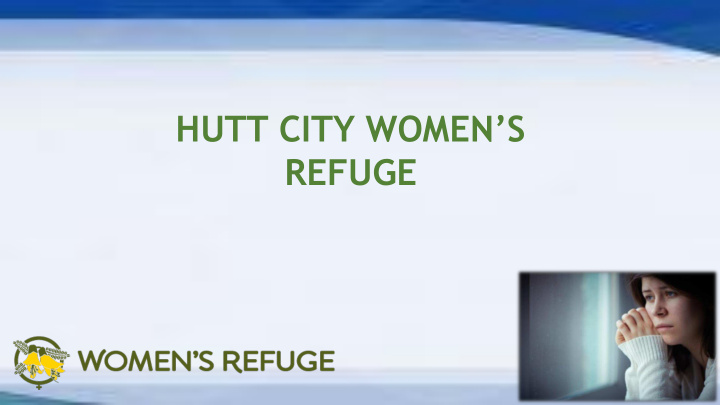



HUTT CITY WOMEN’S REFUGE
2016 STATISTICS New Zealand 118,910 family violence investigations by police 33,000 reported to refuge by police 41% Of frontline Police officers time – Domestic Violence 4268 Protection orders granted 15,000 Police safety Orders More than 80 per cent of women who are murdered are murdered by their partner.
STATISTICS Of women Of children 1 % 30 % were aged under 17 years were under 5 years of age 22 % 33 % were aged 17 - 25 years were aged 5 - 9 years 31 % 28 % were aged 26 - 35 years were aged 10 - 16 years 24 % 2 % were aged 36 - 45 years were over 16 years 17 % were aged 46 years+ 7 % were unknown 5 % were unknown
COST TO NEW ZEALAND Police believe only about 17 per cent of family violence was reported $4.5 billion – $7 billion per year
STATISTICS HUTT VALLEY Hutt Valley Second Highest rate of Domestic Violence in NZ Manakau has the highest rate Hutt Refuge Statistics 2592 contacts per year 643 Bed nights in Safe House from 1 st July 2017 to date (adults only – children not recorded)
HUTT VALLEY WOMENS REFUGE Refuge run by collective 2012 Governance Board established 2015 / 2016 Crisis in funding 2016 / 2017 Restructure
OUR SERVICES Services now provided to Upper Hutt Hutt Womens refuge Counselling Group sessions Support for children Repeat clients On average, a woman will leave an abusive relationship 5 - 7 times before she leaves for good. Leaving is the most dangerous time for women in abusive relationships.
REASONS WOMEN RETURN TO ABUSER Exiting the relationship is most unsafe time for a victim. As the abuser senses that they’re losing power, they will often act in dangerous ways to regain control over their victim. Abuse victims will "leave out of either fear, anger or resentment," he said. "But then, after the fear, anger or resentment begins to subside, they feel guilt, shame, anxiety, and that takes them back." After a violent incident, there is often a "honeymoon period" during which the abuser may apologize profusely, give the victim gifts and persuade the victim to stay, experts say. But when that period is over, the abuser may once again become violent
THE SAFE HOUSE AT RISK
THE VICTIM THE ABUSER Grief & Loss • Guilt • Confusion • Hurt Pride • Anger • Loss of Control • Fear • Anger • Loss of Mana •
RECENT STORY
SAFE HOUSE IMPROVEMENTS
SOLUTION – ELECTRIC GATE
HELPING AS AN • BE A COLLECTOR FOR OUR ANNUAL APPEAL (July) INDIVIDUAL • DONATE A SMALL MONTHLY AMOUNT • DONATE • SNAPPER CARDS WITH FUNDS ON • PETROL VOUCHERS • POWDERED / LONG LIFE MILK • VOLUNTEER • CRISIS LINE – Evenings / Weekends • 1 OR ½ DAY A WEEK – at the Office
Recommend
More recommend